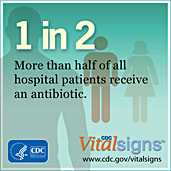Implementation Resources
CDC Implementation Resources
Do you know what to expect if you are a hospitalized patient and have been prescribed an antibiotic?
Access the CDC fact sheet for hospitalized patients [PDF – 973 KB].
Implementation of Antimicrobial Stewardship Core Elements at Small and Critical Access Hospitals
Web Version: https://www.cdc.gov/getsmart/healthcare/implementation/core-elements-small-critical.html
PDF Version: https://www.cdc.gov/getsmart/healthcare/implementation/core-elements-small-critical.pdf [PDF – 14 pages]
CDC Core Elements of Hospital Antibiotic Stewardship Programs
The CDC has highlighted the need to improve antibiotic use as one of four key strategies required to address the problem of antibiotic resistance in the U.S. and has recommended that all hospitals implement antibiotic stewardship programs to support this effort. This guide will focus on implementing and expanding antibiotic stewardship programs to improve the use of antibiotics in hospital settings.
Access the CDC Core Elements of Hospital Antibiotic Stewardship Programs:
Web Version: https://www.cdc.gov/getsmart/healthcare/implementation/core-elements.html
PDF Version: https://www.cdc.gov/getsmart/healthcare/pdfs/core-elements.pdf [PDF – 986 KB]
Checklist for Core Elements of Hospital Antibiotic Stewardship Programs
The following checklist is a companion to the CDC Core Elements of Hospital Antibiotic Stewardship Programs. This checklist should be used to systematically assess key elements and actions to ensure optimal antibiotic prescribing and limit overuse and misuse of antibiotics in hospitals.
Access the Checklist:
Web Version: https://www.cdc.gov/getsmart/healthcare/implementation/checklist.html (for html version)
PDF Version: https://www.cdc.gov/getsmart/healthcare/pdfs/checklist.pdf [PDF – 425 KB]
Assessment tools for antibiotic use
The primary goal of antibiotic stewardship efforts is to optimize the use of antibiotics. However, assessing “optimal” or “appropriate” antibiotic use remains a challenge. To begin addressing the challenge, CDC, in consultation with a variety of external experts, has developed assessment tools that can help facilities explore potential opportunities for improving antibiotic use.
Two of the forms address specific infections, urinary tract infections and community acquired pneumonia. A third form addresses the use of agents commonly use to treat resistant Gram-positive organisms. These three forms draw heavily from existing treatment guidelines to help identify variations in diagnostic evaluation and antibiotic use that deviate from general recommendations.
There is also a fourth, general antibiotic use form that lays out generally accepted best practices in antibiotic prescribing.
The forms are not designed to definitively detect errors in antibiotic prescribing. Rather, they are quality improvement tools intended to highlight situations where providers may be deviating from recommended practices. Areas where there is considerable variation from recommendations could present good opportunities for further exploration.
Users are free to modify the forms in ways that meet their needs. CDC would certainly appreciate learning from people who do use the forms and have ideas on how they can be improved or examples of how they were useful. Any comments can be sent to hip@cdc.gov.
Access the Assessment Tools:
- Strategies to assess antibiotic use to drive improvements in hospitals [PDF – 461 KB] New!
- Assessment of Appropriateness of Antibiotics for Urinary Tract Infections (UTIs) [DOC – 18 KB] February 2014
- Assessment of Appropriateness of Antibiotics for Community-Acquired Pneumonia (CAP) [DOC – 16 KB] February 2014
- Assessment of Appropriateness of Antibiotic Use for Resistant Gram-Positive Infections [DOC – 15 KB] February 2014
- Assessment of Appropriateness of Inpatient Antibiotics [DOC – 16 KB] February 2014
CDC/IHI Antibiotic Stewardship Drivers and Change Package
CDC/IHI Antibiotic Stewardship Drivers and Change Package
The Centers for Disease Control and Prevention (CDC) and the Institute for Healthcare Improvement (IHI) partnered in an effort to develop this conceptual model of key drivers for reducing inappropriate antibiotic utilization. Content experts contributed to the development of this robust driver diagram and change package with a recognition and emphasis on practicality and ease of implementation in all hospitals.
From September 2011 to June 2012, CDC and IHI worked with eight hospitals on pilot testing the enclosed set of recommendations to assess the feasibility of implementation in hospitals of varying size, acuity, and location. The Driver Diagram and Change Package were modified based on that pilot testing.
The Driver Diagram attempts to lay out the various processes that can lead to optimal antibiotic use. The broad categories of these processes are referred to as Primary and Secondary Drivers. The Change Package outlines a number of specific interventions that have either been demonstrated to or experts believe will positively impact the drivers. The ultimate goal is to use the interventions in the Change Package to “drive” improved antibiotic use.
We do not recommend that any facility attempt to implement all of the interventions at once.
There are a large number of interventions outlined in the Change Package, and attempting to implement too many at one time will likely create huge challenges. Rather, the Change Package is meant to serve as a menu of options from which facilities can select specific interventions to improve antibiotic use.
Selection of specific interventions to implement should be tailored to the areas that most need improvement at each facility.
Facilities should assemble a multi-disciplinary team of physicians, pharmacists, nursing, microbiology and administration to discuss the aspects of antibiotic use that are most in need of improvement. The team can then select specific interventions from the Change Package to address those issues. It is important to select the interventions that are most supported by clinical staff.
It is essential to monitor and measure.
The Driver Diagram and Change Package come with a Measurement Framework, which suggests various measures of antibiotic use that might be useful to assess the effectiveness of improvements. Just as important is the measurement of “small tests of change” to assess the implementation of interventions. Reviews of small numbers of charts or discussions with clinicians can identify potential barriers to implementation.
The Driver Diagram and Change Package are living documents that should continue to be refined as we gain more experience with implementation and more data on how to improve antibiotic use. CDC welcomes your suggestions for ways we can improve these documents. Please let us know if you discover barriers to implementing interventions, ways to overcome barriers or other interventions that prove effective in your facility. We would also welcome suggestions you have for ways that you were able to monitor improvements in antibiotic use. Please feel free to submit comments to: hip@cdc.gov.
Other Resources
Other Resources
-
Redefining the Antibiotic Stewardship Team: Recommendations from the American Nurses Association/Centers for Disease Control and Prevention Workgroup on the Role of Registered Nurses in Hospital Antibiotic Stewardship Practices [PDF – 865 KB]
Nurses play a pivotal role in antibiotic stewardship. Read about how nurses can improve antibiotic use to provide safer, better patient care. - Clinician Guide for Collecting Cultures
-
CME/CPE – Optimizing Antimicrobial Therapy with Timeouts (Stanford University School of Medicine and Tufts University School of Medicine)
Antibiotic misuse is widespread and has dire patient and public health consequences. National organizations, including the CDC and the Joint Commission, advocate for a formal “Antibiotic Timeout” to reassess empiric antibiotics 48-72 hours after their initiation. This CME/CPE activity provides a practical approach to performing “Antibiotic Timeouts” in the inpatient setting. Using short, didactic sessions, we will provide examples on how to reassess antibiotic therapy started empirically using clinical, laboratory, and microbiological data. The majority of this CME/CPE will be high-yield, interactive inpatient cases covering skin and soft tissue infections, pneumonia, catheter-associated urinary tract infections, and neutropenic fever, that illustrate the timeout process and the principles of appropriate use of antimicrobials. - Infection Control Transfer Form Example 1 [PDF – 263 KB]
- Infection Control Transfer Form Example 2 [PDF – 240 KB]
- Penn CDC Prevention Epicenters Program – Antimicrobial Stewardship Initiative
- Penn CDC Prevention Epicenters Program – Antimicrobial Stewardship Checklist [PDF – 244 KB]
- Society for Healthcare Epidemiology of America – Antimicrobial Stewardship
- Stewardship Education
- Society of Infectious Diseases Pharmacists
- Page last reviewed: February 27, 2017
- Page last updated: July 21, 2017
- Content source:




 ShareCompartir
ShareCompartir
